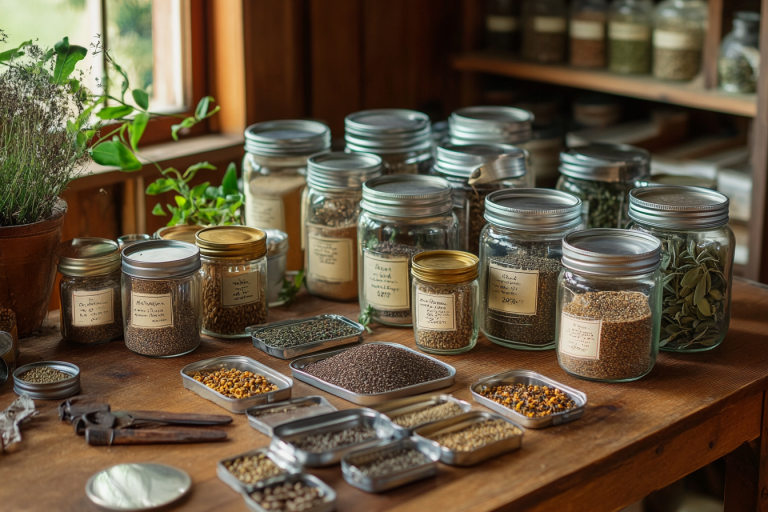Heirloom seeds are not just seeds; they are a living legacy passed down through generations, each variety carrying a unique story and genetic makeup. In an age where agricultural practices lean towards hybridization and genetically modified organisms (GMOs), the preservation of heirloom seeds has become a crucial endeavor. These seeds represent biodiversity, food security, and cultural heritage, making their preservation essential for future generations. In this comprehensive guide, we will explore the best practices for saving and storing heirloom seeds to ensure their vitality and viability for years to come.
Understanding Heirloom Seeds
Heirloom seeds are open-pollinated seeds that have been handed down from one generation to the next, often for at least 50 years. Unlike hybrid seeds, which are bred for specific traits and often do not produce true-to-type offspring, heirloom seeds retain the characteristics of the parent plant, ensuring consistency and reliability in the garden. These seeds are treasured for their superior flavor, adaptability, and resistance to local pests and diseases. By preserving heirloom seeds, we are not only safeguarding plant diversity but also maintaining a connection to our agricultural heritage.
Why Preserve Heirloom Seeds?
The preservation of heirloom seeds is essential for several reasons:
- Biodiversity: Heirloom seeds contribute to the genetic diversity of our food supply, providing a buffer against the loss of plant species due to changing environmental conditions or diseases.
- Cultural Heritage: Many heirloom seeds are tied to specific regions, cultures, and traditions. By preserving these seeds, we are keeping the stories and practices of our ancestors alive.
- Food Security: In a world facing the challenges of climate change and dwindling natural resources, heirloom seeds offer resilience and adaptability. They can thrive in diverse climates and conditions, making them a valuable resource for sustainable agriculture.
- Flavor and Nutrition: Heirloom varieties are often prized for their superior taste and nutritional content compared to commercial hybrids. Preserving these seeds ensures that future generations can enjoy the rich flavors and health benefits of heirloom produce.
How to Save Heirloom Seeds
Saving heirloom seeds is a rewarding process that requires careful planning and attention to detail. The following steps will guide you through the process:
- Selecting the Right PlantsChoose healthy, robust plants that exhibit the desired traits of the heirloom variety. It is crucial to avoid saving seeds from plants that show signs of disease or poor growth, as these traits may be passed on to future generations. Select plants that are true to type, meaning they closely resemble the characteristics of the original variety.
- Pollination ControlTo maintain the purity of heirloom seeds, it is essential to control pollination. Cross-pollination with other varieties can result in hybrid seeds that do not retain the true characteristics of the heirloom plant. For plants that are prone to cross-pollination, such as corn or squash, consider using physical barriers like bags or cages to isolate flowers and prevent unintended cross-pollination.
- Seed HarvestingHarvesting seeds at the right time is critical to ensure their viability. Allow fruits and vegetables to fully ripen on the plant before harvesting seeds. For dry seeds, such as beans or peas, wait until the pods have dried and turned brown before collecting them. For wet seeds, such as tomatoes or cucumbers, scoop out the seeds and remove any pulp or debris.
- Cleaning SeedsProperly cleaning seeds is necessary to remove any remaining plant material, which can harbor mold or diseases. For dry seeds, gently thresh the seeds by hand or use a sieve to separate them from the chaff. Wet seeds should be rinsed thoroughly to remove any remaining pulp, then spread out on a clean surface to dry.
- Drying SeedsSeeds must be completely dry before storage to prevent mold and ensure longevity. Spread the cleaned seeds on a screen, paper towel, or shallow dish in a well-ventilated area away from direct sunlight. Stir the seeds occasionally to promote even drying. Depending on the seed type, drying can take anywhere from a few days to several weeks.
Storing Heirloom Seeds
Proper storage is crucial for maintaining the viability of heirloom seeds. Follow these guidelines to ensure your seeds remain viable for future planting:
- Choosing the Right ContainerStore seeds in airtight containers to protect them from moisture and pests. Glass jars, metal tins, or vacuum-sealed bags are excellent choices for long-term storage. Avoid using plastic bags, as they can allow moisture to seep in and damage the seeds.
- Temperature and Humidity ControlSeeds should be stored in a cool, dry place to prevent deterioration. The ideal storage temperature is between 32°F and 41°F (0°C to 5°C), which can be achieved by storing seeds in a refrigerator or a cool basement. Humidity levels should be kept below 8%, as high humidity can lead to mold growth and reduced seed viability.
- Labeling and OrganizationClearly label each container with the seed variety, harvest date, and any specific notes about the plant’s characteristics. This information will be invaluable when it comes time to plant the seeds. Organize your seed collection by type, year, or other criteria that make it easy to find the seeds you need.
- Monitoring Seed ViabilityOver time, seed viability can decline, so it’s essential to monitor your seeds regularly. Conduct a germination test every few years by planting a small sample of seeds in a damp paper towel or soil. If less than 70% of the seeds germinate, it may be time to replenish your seed stock with fresh seeds.
Conclusion
Preserving heirloom seeds is a vital practice that connects us to our past while securing the future of our food supply. By carefully saving and storing these seeds, we can ensure that the rich diversity of plant varieties, flavors, and traditions continues to thrive for generations to come. Whether you are an experienced gardener or just beginning your journey into seed saving, the knowledge and practices shared in this guide will help you preserve the legacy of heirloom seeds and contribute to the sustainability of our agricultural heritage.

